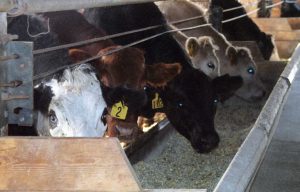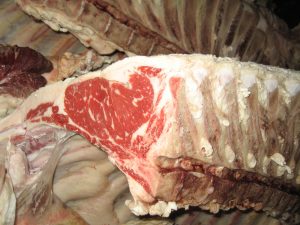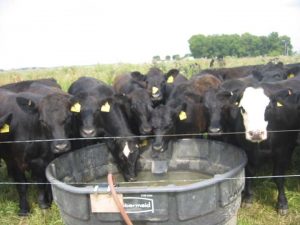
The beef industry in Washington State is a dynamic industry that has the potential for a number of marketing channels. As more Washington residents are acquiring land and looking for alternate uses for the land, beef cattle are looked at as a viable option. Although large and do require more space beef cattle tend to be considered easy care livestock. Regardless of your level of experience and knowledge of the beef industry having the tools to successfully raise those animals is important. Whether you have one animal, ten animals or more, knowledge is important. In todays markets consumers are exercising their ability to request for specific trends such as organic, natural, humanely raised, raised with low environment impact, etc. in the market place. Although this is not a complete list of topic areas for raising, managing and marketing beef it is a useful resource.

Beef Cattle Production and Management: Beef production can vary depending on the type of operation that you choose. The type of production operation will dictate management decisions such as feed resources (pasture, hay, grain, supplements, etc.,), housing requirements, land and beef cattle management and care, and may define marketing channels (organic, all natural, pasture raised, grain-fed, etc.,) as a result of how you raise and care for your animals. Understanding the goals of your farm and the cattle you choose to raise is paramount to the success of your operation. Many large operations are single specie operations making management decisions and planning a bit more streamlined. Many small to medium size operations have a diversified animal and/or plant or crop based environment. Diversification can result in improved plant bio-diversity and more efficient land management through out the year, as well as healthier and more productive pastures/grasslands. There are many examples for co-mingling and models to follow for success.
The following links will aid new or established producers understanding basic animal production. Meeting the basic needs defined in animal management is paramount to good livestock stewardship.
- Beef Production for Small Farms 2000, G.J. Pirelli, Oregon State University, EC 1514. Excellent for areas west of the Cascades.
- Raising Beef Cattle on a Few Acres. 1999. Dale ZoBell, Craig Burrell, and Clell Bagley, Utah State University.

Beef Cattle Nutrition: Understanding beef cattle nutrition will assure that your animals reach their potential and help you to manage your animals resulting in a more efficient use of the environment. Many assume that grass and/or grain will offer the same end result. Stage of production may result in requirements changing. For example when we compare a dry beef cow with a lactating beef cow with calf at side, the dry beef cow has a low energy requirement where as the lactating beef cow requires more energy maximizing her performance as she has more demands. The lactating cow will need additional feed resources both in increased quantity and quality in order to maximize milk production and subsequently higher performance for her calf. Understanding forage, grains, and supplements or additive feeds will allow you to use items that will improve production. This will also allow you to select the most cost effective feedstuffs possible for the region and the season. There are a number of nutritional programs that one can follow, yet they all take point of production into consideration and diets are then adjusted accordingly. Formulated feeds from some of the popular feed companies can make things easy when your first starting out, however these are formulated for the most common animal needs and may not be specific to your operation. Custom feeds working with a reputable feed mill and nutritionist will allow you to optimize your performance as a result of the most efficient nutritional program.
- Weaning on Pasture for Low-Stress Beef Production. October 30,2003, Dr. Jim Gerrish, Grazing Land Consultant, Washington State University.
- Rotational Grazing: Livestock Systems Guide November 2004, Alice Beetz, Appropriate Technology Transfer for Rural Areas (ATTRA).
- Supplementing Cattle on Drought Affected Pastures and Ranges. March 2003, James R. Males, John Unruh, Bill McReynolds, Washington State University.
- Beef Cattle Feed Management During Drought. January 2000. Roger Brownson, Beef Cattle Specialist, Montana State University.
- Cattle Management During Drought. January 2000. Roger Brownson, Beef Cattle Specialist, Montana State University.
- Low Stress Weaning Alternatives for Cow-Calf Producers: Fenceline-Weaning September 2011. Kerry A. Rood MS, DVM, Extension Veterinarian, Utah State University.

Beef Cattle Health: The health of your beef herd is another key component that ties into production efficiency. Understanding how to care for your animals to reduce illness, disease and parasites all the while maintaining bio-security on ranch/farm can sometimes be a daunting task. A few key things can help with this. First and foremost determining the type of operation that you are running and the calendar of events. By doing this you should have a set schedule for annual vaccinations and health management concerns. Secondly, establishing a Veterinary Client Patient Relationship. This can be a simple meet and greet allowing you to work with a local medical professionals on health concerns through out the animal management year. Additionally having a herd health plan and calendar for your beef cattle will take the guess work out of the daily operations. Observation of your beef animals for normal activity and behavior will prepare you when abnormal activity occurs.
- Survey to Assess Parasite Control Methods Utilized by Washington Beef Cattle Producers. 2006, H.Ferguson, S.O’Neal, D.Walsh, A.Linton. Washington State University.
- Reduced Risk Pest Management Strategies in Beef Cattle. May 2010, D. Walsh, S. O’Neal, H. Ferguson, and G. Peck. Washington State University.

Beef Cattle Processing and value-added products: With in the beef market there are many alternatives that have emerged compared to marketing in the traditional (conventional) market. Beef is one of the highest consumed proteins in the United States. Most consumers are looking for the lowest price point regardless of their economic status. Some consumers are willing to pay more for specific trends in the retail meat case. Consumers would agree, a product that they feel confident is wholesome and tastes good is paramount. Consumers today want that personal touch. Knowing the story about how an animal was raised and the care that it was given. This happens when products are direct marketed. Adding that personal touch could allow you to price your item higher than conventional markets.
- Food Safety is Your Business. Revised December 2001, Jean Smith, Darla Marks, Jan Busboom, Washington State University.
- San Juan Farmers’ Plan is a Cut Above, 11-26-2001. Lynda V. Mapes, Seattle Times Newspaper.

Beef Cattle Business Management and Marketing: Managing a beef cattle operation can be costly and knowing the proper way to budget and plan will help. Regardless if your operation is your sole source of income, supplemental income or a hobby business management and marketing are key to success. There are numerous marketing options for Small Farms in Washington State for food animal products. Although many small farms are looking for alternative marketing options, some choose to enter the conventional markets either through auction channels, buy days, feedlots, packers, etc., as a result of ease. Niche’ markets and direct marketing can be rewarding. Having said that the challenges can out weigh the benefits resulting in frustration. Researching what others have done and developing a marketing plan with realistic goals is paramount to your success. Direct marketing is an avenue for consumers who wish to know more about their food. Tag lines such as organic, local, all natural, etc. meeting the defined standards set by USDA will peak consumers interest in the market place. Some of these marketing claims have restrictions by USDA, FDA, or others depending on the branding constraints.
- Beef Marketing Alternatives, 2006. Anne Fanatico and Lee Rinehart, Appropriate Technology Transfer for Rural Areas (ATTRA).
- How to Direct Market Your Beef. 2005. J.Holder. The Sustainable Agriculture Network.
Photo Credits: All photos on this page courtesy of Paul Kuber, WSU (formerly of Ohio State University Extension).